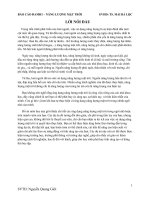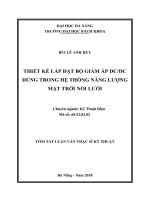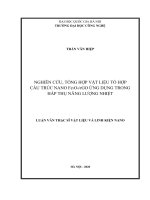Slide vật liệu ứng dụng trong chuyển hóa năng lượng mặt trời
Bạn đang xem bản rút gọn của tài liệu. Xem và tải ngay bản đầy đủ của tài liệu tại đây (2.15 MB, 16 trang )
ng
th
an
co
ng
.c
om
VẬT LIỆU ỨNG DỤNG
TRONG CHUYỂN HÓA
NĂNG LƯỢNG MẶT TRỜI
u
du
o
TS. NGUYỄN TUYẾT PHƯƠNG
cu
ĐH KHOA HỌC TỰ NHIÊN TP.HCM – THÁNG 10 NĂM 2017
1
CuuDuongThanCong.com
/>
.c
om
1. Introduction
co
ng
Global energy
an
Photovoltaic technology
ng
th
Materials in solar energy conversion
du
o
2. Silicon solar cells
u
3. Inorganic thin film solar cells
cu
2
Outline
6. Hybrid solar cells
CuuDuongThanCong.com
/>
.c
om
an
co
ng
(BP) The world energy consumption:
- grew 5.6% in 2010, the highest rate since
1973
- will at least double by 2050 with a
predicted population of approximately
nine billion
ng
th
World Population Forecast to 2050
from International Futures
du
o
/>
u
World energy use [1]
cu
3
1. Introduction
Global energy
All the scenarios to 2050 have been analyzed
based on an increasing World population, a
slow economic growth, a reduction of
available fossil fuel, the problem of CO2
emission and climate change policy, etc. for a
sustainable development
[1] International Energy Agency: Energy
technology perspective 2008 – Scenarios and strategies to 2050
CuuDuongThanCong.com
/>
.c
om
The International Energy Agency (IEA):
co
ng
“How to achieve a clean, clever and competitive
energy future”
u
du
o
ng
th
an
Renewable energy resources: solar energy, wind
energy, geothermal energy, bio-energy, ocean
energy, hydrogen power and other natural resources
cu
4
1. Introduction
Global energy
Recommended annual production of World
renewable electricity (European
Commission: World energy technology
outlook – 2050)
CuuDuongThanCong.com
Use of renewable energy: 35 – 46% of total
power generation requirement by 2050
More than 30% of world electricity coming
from renewable energy
Beyond 2030, solar energy becomes an important
factor for the generation of electricity by for example
thermodynamic power plants and photovoltaic systems
integrated into buildings.
/>
.c
om
Photovoltaic (PV): the most direct way to convert solar
radiation into electricity based on the photovoltaic effect
an
co
(1) The absorption of light to generate an electron –
hole pair
du
o
ng
th
(2) The separation of electron and hole by the structure
of the device – electrons to the negative terminal and
holes to the positive terminal – thus generating
electrical power.
u
~ 10% 60 TW
ng
1.7 x 105 Tera-Watt
600 TW
cu
5
1. Introduction
Photovoltaic
Energy demand : ~ 28 TW
(2050)
CuuDuongThanCong.com
/>
.c
om
ng
co
an
th
ng
du
o
u
cu
6
1. Introduction
Photovoltaic
CuuDuongThanCong.com
/>
1. Introduction
Photovoltaic operation
.c
om
7
co
2.0
Jsc
2
th
an
Pmax
1.5
du
o
ng
1.0
Voc
u
0.5
0.0
0
200
cu
J/ mA/cm
The standard condition for efficiency
measurement of solar cell:
1 Sun, AM 1.5 G, 25oC (1.000 W/m2)
ng
A solar cell is determined by measuring the
photo current density J at different potentials V.
400
Voltage/ mV
600
J – V curve of a DSC, produced with the N719 dye and
non-robust electrolyte.
Light intensity: 100 W/m2, active area of DSC: > 8.0
cm2, η: 7.05%, FF: 64%.
CuuDuongThanCong.com
Overall solar to electrical energy
conversion efficiency
η=
J sc Voc FF
Pin
Fill factor of the cell
Pmax
FF =
J sc Voc
/>
.c
om
u
du
o
ng
th
an
co
ng
Updated table of solar cell performance
cu
8
1. Introduction
Photovoltaic
CuuDuongThanCong.com
/>
.c
om
ng
co
an
th
ng
du
o
u
cu
9
Silicon Solar cells
CuuDuongThanCong.com
/>
.c
om
ng
co
an
th
ng
du
o
u
cu
10
Silicon Solar cells
CuuDuongThanCong.com
/>
.c
om
ng
co
an
th
ng
du
o
u
cu
11
Silicon Solar cells
CuuDuongThanCong.com
/>
.c
om
ng
co
an
th
ng
du
o
u
cu
12
Inorganic thin film solar cells
CuuDuongThanCong.com
/>
.c
om
ng
co
an
th
ng
du
o
u
cu
13
Inorganic thin film solar cells
CuuDuongThanCong.com
/>
.c
om
ng
co
an
th
ng
du
o
u
cu
14
Inorganic thin film solar cells
CuuDuongThanCong.com
/>
u
du
o
ng
th
an
co
ng
.c
om
Hybrid solar cells
cu
15
CuuDuongThanCong.com
/>
.c
om
ng
co
an
th
ng
du
o
u
cu
16
Hybrid solar cells
Dye-sensitized Solar cells
CuuDuongThanCong.com
/>









